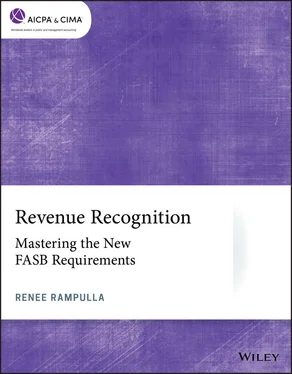Based on the assessment of the facts and circumstances, Big Pharma Inc. determines that it expects to provide a price concession and accept a lower amount of consideration from Jenco Corporation. Accordingly, Big Pharma Inc. concludes that the transaction price is not $1 million and, therefore, the promised consideration is variable. Big Pharma Inc. estimates the variable consideration and determines that it expects to be entitled to $400,000.
Is consideration probable because the implicit price concession is not the stated price consideration Big Pharma Inc. expects to receive from Jenco Corporation?
FASB ASC 606 permits, as a practical expedient, the application of a portfolio approach for contracts with customers having similar characteristics, provided that the effects on the entity’s financial statements would not differ materially had FASB ASC 606 been applied to each individual contract within that portfolio.
How should an entity assess whether the results of a portfolio approach would differ materially from the application of FASB ASC 606 on a contract-by-contract basis? FASB indicates in the Basis of Conclusions (BC) paragraph, paragraph 69, of Accounting Standards Update No. 2014-09, Revenue from Contracts with Customers (Topic 606) , that it did not intend for an entity to quantitatively evaluate each outcome and, instead, the entity should be able to take a reasonable approach to determine the portfolios that would be appropriate for its types of contracts.
When determining whether to apply step one to each individual contract with a customer or to elect the portfolio approach practical expedient, an entity will need to assess the cost versus benefits. Some entities may determine that the portfolio approach is best applied in step one, and perhaps even step 3 in the application of FASB ASC 606, but this is based on varying facts and circumstances.
Although not all inclusive, the following are some entities that may benefit from the application of the portfolio approach:
A health care entity might want to consider the application of the portfolio approach. For example, it may evaluate whether to establish separate portfolios for uninsured self-pay patients, insured patients with co-payments, insured patients with deductibles, emergency room uninsured self-pay, elective surgery that is not medically necessary or covered by insurance, and so on.
An educational institution may consider applying the portfolio approach when assessing collectibility of tuition and housing.
1 A contract with a customer exists only when:Each party to the contract has the unilateral enforceable right to terminate a wholly unperformed contract without compensating the other party or parties.The contract lacks commercial substance, so the risk, timing, and the amount of the entity’s future cash flows are expected to change as a result of the contract.It is probable that the entity will collect some of the consideration to which it will be entitled in exchange for the goods or services that will be transferred to the customerThe parties to the contract have approved the contract (in writing, orally, or in accordance with other customary business practices) and are committed to perform their respective obligations.
2 The collectability assessment when assessing whether a contract exists with a customer:Is partly a forward-looking assessment, requiring an entity to use their judgment and consider all of the facts and circumstances, including customary business practices and the entity’s knowledge of the customer.Is based on the customer’s ability and intention to pay the entire amount of promised consideration for the entire duration of the contract.Is determined based on customary business practices that indicate that the seller’s exposure to credit risk is greater than the entire consideration promised in the contract.Allows an entity with the ability to limit their exposure to credit risk by continuing to provide the transferring of additional goods or services to a customer in the event that the customer fails to pay consideration when it is due.
If a contract meets the five-step criteria at assessment, an entity will not reassess the existence of a contract unless there is a significant change in the facts. At times, contracts may be modified for changes in scope, price, or both. A contract modification exists when the parties to a contract approve a modification that either creates new or changes existing enforceable rights and obligations of the parties involved in the contract. For example, a customer’s financial capabilities may deteriorate to the point that further collectability ceases to be probable and therefore the entity may need to reassess whether a contract for future goods or services continue to exist.
When a contract with a customer does not meet the five criteria and an entity receives consideration from the customer, the entity should recognize the consideration received as revenue only when one or more of the following events have occurred:
The entity has no remaining obligations to transfer goods or services to the customer, and all, or substantially all, of the consideration promised by the customer has been received by the entity and is non-refundable.
The contract has been terminated, and the consideration received from the customer is non- refundable.
The entity has transferred control of the goods or services to which the consideration that has been received relates, the entity has stopped transferring goods or services to the customer (if applicable) and has no obligation under the contract to transfer additional goods or services, and the consideration received from the customer is non-refundable.
An entity should recognize the consideration received from a customer as a liability until one of the above events occurs or until the five criteria are subsequently met. Depending on the facts and circumstances relating to the contract, the liability recognized represents the entity’s obligation to either transfer goods or services in the future or refund the consideration received. In either case, the liability should be measured at the amount of consideration received from the customer.
 Example 2-2 4Reassessing the criteria for identifying a contract
Example 2-2 4Reassessing the criteria for identifying a contract
Longo Technologies licenses a patent to Sutra Inc., its customer, in exchange for a usagebased royalty. At the contract inception, the contract meets all the collectability criteria and Longo Technologies accounts for the contract with the Sutra Inc. in accordance with FASB ASC 606. Longo Technologies recognizes revenue when Sutra Inc.’s subsequent usage of the licensed patent occurs.
First year of the contract
Sutra Inc. provides quarterly reports of usage and pays within the agreed-upon period.
Second year of the contract
Sutra Inc. continues to use Longo Technologies’ patent, but its financial condition declines.
Sutra Inc.’s current access to credit and available cash on hand are limited.
Longo Technologies continues to recognize revenue on the basis of Sutra Inc.’s usage throughout the second year.
Sutra Inc. pays the first quarter’s royalties but makes nominal payments for the usage of the patent in quarters 2, 3, and 4.
Longo Technologies accounts for any impairment of the existing receivable and any credit losses on existing contract balances in accordance with other appropriate FASB ASC topics.
Third year of the contract
Sutra Inc. continues to use Longo Technologies’ patent.
Читать дальше

 Example 2-2 4Reassessing the criteria for identifying a contract
Example 2-2 4Reassessing the criteria for identifying a contract










